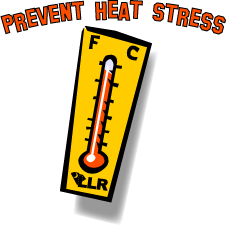Title Page
-
File Name
-
Client / Site
-
Conducted on
-
Prepared by
-
Location
-
Personnel
Main Section
TRAINING
-
All personnel have attended heat stress training
-
Compliance level
- 0 - Critically non-compliant
- 1 - Largely non-compliant
- 2 - Partially compliant
- 3 - Substantially compliant
- 4 - Fully compliant
- N/A
-
Add media
-
Additional awareness training is conducted during hotter months
-
Compliance level
- 0 - Critically non-compliant
- 1 - Largely non-compliant
- 2 - Partially compliant
- 3 - Substantially compliant
- 4 - Fully compliant
- N/A
-
Add media
PROCEDURES
-
Risk register captures heat stress
-
- 0 - Critically non-compliant
- 1 - Largely non-compliant
- 2 - Partially compliant
- 3 - Substantially compliant
- 4 - Fully compliant
- N/A
-
Add media
-
Emergency response plan identifies how to manage heat stress medical incidents
-
Compliance level
- 0 - Critically non-compliant
- 1 - Largely non-compliant
- 2 - Partially compliant
- 3 - Substantially compliant
- 4 - Fully compliant
- N/A
-
Add media
-
Heat Stress Management Plan developed, known by crew and available on site
-
- 0 - Critically non-compliant
- 1 - Largely non-compliant
- 2 - Partially compliant
- 3 - Substantially compliant
- 4 - Fully compliant
- N/A
-
Add media
-
Procedures identify heat stress as a risk when task is being conducted
-
- 0 - Critically non-compliant
- 1 - Largely non-compliant
- 2 - Partially compliant
- 3 - Substantially compliant
- 4 - Fully compliant
- N/A
-
Add media
-
Hydration form used during heat stress months to monitor fluid intake and loss during heat stress months
-
- 0 - Critically non-compliant
- 1 - Largely non-compliant
- 2 - Partially compliant
- 3 - Substantially compliant
- 4 - Fully compliant
- N/A
-
Add media
HEATSTRESS CONTROL STRATEGIES
-
Rig moves are conducted during the cooler part of the day
-
- 0 - Critically non-compliant
- 1 - Largely non-compliant
- 2 - Partially compliant
- 3 - Substantially compliant
- 4 - Fully compliant
- N/A
-
Add media
-
Truck drivers and Electricians are monitored on location when loading/unloading and rigging up/down camp
-
- 0 - Critically non-compliant
- 1 - Largely non-compliant
- 2 - Partially compliant
- 3 - Substantially compliant
- 4 - Fully compliant
- N/A
-
Add media
-
Heat Stress is discussed and documented in the safety meeting prior to rig move
-
- 0 - Critically non-compliant
- 1 - Largely non-compliant
- 2 - Partially compliant
- 3 - Substantially compliant
- 4 - Fully compliant
- N/A
-
Add media
-
Adequate supply of drinking water is available including drink containers, personal drink bottles etc.
-
- 0 - Critically non-compliant
- 1 - Largely non-compliant
- 2 - Partially compliant
- 3 - Substantially compliant
- 4 - Fully compliant
- N/A
-
Add media
-
Electrolyte supplements available and used
-
- 0 - Critically non-compliant
- 1 - Largely non-compliant
- 2 - Partially compliant
- 3 - Substantially compliant
- 4 - Fully compliant
- N/A
-
Add media
-
Sufficient crew available to assist with camp move
-
- 0 - Critically non-compliant
- 1 - Largely non-compliant
- 2 - Partially compliant
- 3 - Substantially compliant
- 4 - Fully compliant
- N/A
-
Add media
-
Hydration charts available on location to assist with assessing hydration levels
-
- 0 - Critically non-compliant
- 1 - Largely non-compliant
- 2 - Partially compliant
- 3 - Substantially compliant
- 4 - Fully compliant
- N/A
-
Add media
-
Medical conditions are known by camp manager that may have an impact on heat stress management
-
- 0 - Critically non-compliant
- 1 - Largely non-compliant
- 2 - Partially compliant
- 3 - Substantially compliant
- 4 - Fully compliant
- N/A
-
Add media
-
Staff can identify and know what signs are associated with the initial onset stages of heat stress
-
- 0 - Critically non-compliant
- 1 - Largely non-compliant
- 2 - Partially compliant
- 3 - Substantially compliant
- 4 - Fully compliant
- N/A
-
Add media
-
Shade and refuge is available for crew during rig move operations
-
- 0 - Critically non-compliant
- 1 - Largely non-compliant
- 2 - Partially compliant
- 3 - Substantially compliant
- 4 - Fully compliant
- N/A
-
Add media
Corrective Actions
-
Corrective action 1
-
Corrective action 2
-
Corrective action 3
-
Corrective action 4
-
Corrective action 5
-
Signatures






